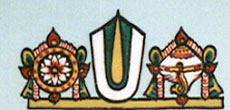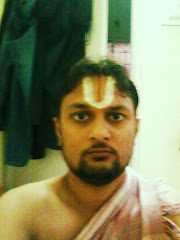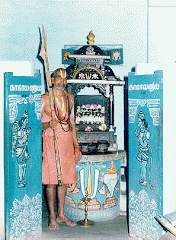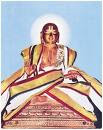Monday, October 12, 2009
Jnaana Yogovyavasthita- Are we demons...contd
This is the third quality in the first sloka describing the divine type. Bhagavan Ramanuja defines this as "prakriti viyuktaatma svarupa viveka nishtaa". This means ,firm adherence to the descrimination between the nature of the self(jeeva atma) and Prakriti( matter). This descriminating knowledge removes "dehaatma brama" or the delusion that "i am the body" . This might appear seemingly simple but to really feel that that the self is different from the body is tough in pragmatic sense. The real nature of self is in its being a Sesha to Sriman Naarayana , and in being a jyaana svarupa and ananda svarupa and paratantra. the nature of prakriti is that it is achit and is subservient to Naarayana and a Bogyam to both jeeva and Brahmam. the upanishad statement " Bhokta Bhogyam Preritaaram cha matva.." says Bhokta is jeeva and Bhogyam is prakriti and the agent who enables (Bhokta to enjoy Bhogyam)this is Naarayana. The self wrongly thinks that"i am the body" and feels that it is svatantra (independent). most of us believe that we are bodies and are independent and are controlling matter. This is called dehaatma brama. Only Pandithas or scholars are capable of having this mind set that "I am a soul residing in my body". Adi Shankara paadacharyal defines a pandita(scholar) as " pandaa aatma vishayaa bhuddih yeshaam te" or a person whose intellect is fixed on understanding his self(aatman). The goal of Jnaana yoga is jeeva aatma sakshatkaara and this has to be aided by karma yoga . For Adi Shankara the essense of gita is Jnaana yoga only ,with Bhakti and karma yoga being just just preparatory steps. {Shankara starts the commentary with -idam dvi prakaaram dharma iti nishrreyes prayoojanam.." To shankara , Gita preaches Pravriti and Nivritti as two different paths and Pravriti marga just helps one to prepare for Nrivritti marga . Shankara says in Bhaja Govindam-"sat sanghathve nisangathvam " To Him , only sanyaasa with Jyana yoga that gives the relization that the self is identical with Nirguna Brahmam leads to Moksha or is itself Moksha.
the essense of Gita is very clearly summum bonum and this has to be acheived by Bhakti alone as Per SriMatham. Karma yoga and Jnaana yoga are two limbs of Bhakti. Bhavan Yaamuna muni says "Sva dharma jyaana vairagya saadya bhaktieka gocharah Naarayana param Brahma Gita shastre samirithah" - The essense of gita is attaining the Parabrahmam- Sriman Narayana by Bhakti alone aided by karma and jyana yoga coupled with vairagya.This is how Gita proceedes from Samkya and karma yoga to jyana yoga coupled with Vairagya and towards the end Bhagavan says "Manmanaa Bhava MadBhaktah Madyaaji Maam Namaskuru.." Also the most famous statement" Sarva dharmaan parityajya maam eekam sharanam vraja..." clearly hints that the Lord wanted to prepare Arjun for Bhakti yoga and Prapatthi by introducing its limbs -karma yoga and Jnaana yoga in the beginning.
A person has to start with Samkya (buddhi) that i am the self and simultaneously practise karma yoga with the afore said mind set-"Tannai kandaa paambaii kandaa poolee"-as rightly said by Shri Pillai Lokaachariyar . slowly the yogi draws his senses from the external objects and meditates on his self and attains aatma sakshatkaara. Then he proceeds to meditate on Brahmam as taught in the Brahma vidyas in the upanishads and attains Paramaatma sakshatkaara by the Lords grace.
the state of Buddhi necessary to embark on karma yoga is the samkya yoga which is preached by The Lord in the beginning. There is a Jnaana element in karma yoga and there is karma aspect of Jyaana yoga and hence both are not totally two different paths as advised By Shankara.The Lord himself says this " Sankya yogou Pritag balah pravadanthi na pandithah"- The learned does not consider sankya and karma yoga as two totally different paths , only children of vedanta will say they are different.
Jyayna yoga is the path of sense restraint and just being with and meditating on the self. Karma yoga is feeding the senses as prescribed by Shastras and with a mind set that "I am not the agent" and sacrificing the fruits of actions to the Lord. This doesnt mean Jnayana yogis donot have karmas or need not do any prescribed activities. the Isa upanishad clearly says " Kurvan eveha karmani jijivishet shatam samah evam tvayi, na anyatoo asti na karma lipyate naree" - do your prescribed duties for 100 years (life time) with a detached mind set. this is the only way and by this way the actions will not bind the soul. hence the Jyaana yogi needs to maintain his body and hence will have to do some karmas and therein he needs to be careful not to lose sense control. Hence the Lord advises Arjun to follow Karma yoga first as Karma yoga is better suited to common people.
In todays circumstances, both Jnaana yoga and karma yoga seems very tough for common people to follow. This is the reason Ramanuja did not advocate the path of yoga for us. In kali yuga Sharanaagathi is the only feasible path. But as Ramanuja rightly explains , we can attempt to think that we are not the body -atleast intellectually if not intrinsically.
Saturday, August 15, 2009
Are we Demods contd.-chapter 16 gita
The next guna which Bhagavan attributes to Divine nature is purity of mind. Shri Emperumaanaar explains this as “satvasya anthah karanasya rajah tamobhyaam Asamsprishtvam “. This means that Purity of mind is a state where in the internal organ (manas) is untouched by Rajo guna and Tamo Guna. In Vedanta these Gunas are known as “Adravya” or non substance. Non substance is that which is devoid of any conjunction . Conjunction causes the knowledge of external relation of a substance. There are ten non-substances like sound, taste, touch etc. the three material natures namely Sattva, rajas and tamas also belong to the category of non-substances. When Prakriti is evolved out of “Mahat” these three qualities pervade the Prakriti in varying proportions. The Jeevatma is not conjoined with these gunas in its pristine form but is binded by these gunas because of association with the body.
Ramanuja further explains that Sattva illuminates on account of its pure nature. Purity means that it is bereft of qualities that veil light (knowlwdge) and happiness(Sukha) . Rajo guna induces Passion and Tamas induces ignorance and deceitful acts. Though Sattva nature is good this is not the “Suddha Sattva “ present in Sri Vaikunta and hence within the sphere of Prakriti it may cause bondage to knowledge and happiness. What is important to understand is that these Gunas will be present in each individual and their proportions change from time to time and person to person. No person can have absolutely just one among them without other two. Bhagavan warns Arjun that “Rajastu Phalam Dhukkam “ and “ ajnayanam tamasah phalam” – the fruit of rajas is pain and tamas is ignorance.
Why should we try to reduce tamas and rajas? Bhagavan answers- “satvaat sanjaayathe jnayanam” – only Sattva increases knowledge of the self and as such is useful for liberation. Ramanuja explains that a seer should first subdue rajas and tamas and should try to increase Sattva guna. Then to remove the bondage caused by Sattva he needs to do “Kartrva buddhi “ tyagam and karma phala tyagam. This will ensure that the seer will rise steadfast towards liberation. Since liberation gives greatest sukha-“anandam” we should follow the path as prescribed by Gitaacharyan.
How do we cultivate purity of mind?
The path as prescribed by Ramanuja for developing purity of mind is as follows
1. Viveka- discrimination between right and wrong and following the right
2. Vimokha- resisting sensual pleasures
3. Abhasyam-practice of discliplines like japa, aradhana , temple visit etc.
4. Kriya-performance of five fold duties of life as prescribed.
5. kalyana- practice of right virtues
6. Anavasaadha- freedom from pessimistic view and depression and maintaining a cheerful attitude.
7. Anuddharsa- maintaining calm without yielding excessively to excitement, despair etc.
Thus by practicing these , we can also can develop purity of mind.
Saturday, August 8, 2009
Are we demons?
we always associate demons with some bad creatures, without the least titillation of alluding ourselves, not to mention , our carelessness and indifference in understanding Shastras , or our easy disposition to breach them to suit our own paradigms that are aligned with our ever perfidious goals of sensual pleasures and other mundane objects. Out of the four known Purusharthas, Artha-wealth, has taken a primordial importance today. In Mahabharata itself we find the same sentiment echoed by Arjuna when he says that without Artha , a man cannot meet other ideals. Even Kaama and Dharma require the support of Artha , says Arjun to Dharmaputra. How do we decide what to do and what not to do?
The basis of action is to be decided upon the direction and sanction of our Shastras . Without Shastras any meaningful discussion on the ethics and human conduct would be futile and no common consensus can ever be reached. These Shastras are the commandment of Our Lord and hence they are construed as the most important Pramana-valid source of knowledge in our Hindu Culture.
Bhagavat Shri Ramanuja in his Gita Bhashya , introduces chapter-16 as the chapter that brings to light the importance of observing shastras and says that those who follow Shastras are divine and those who don’t are demons. Some qualities and conduct of the Divine and the Demons are discussed in this chapter. This chapter is not intended just to elicit compunction but to make us probe into our nature and attempt amendments as much as possible.
Some divine qualities as explained by Udayavar.
Abhayam(fearlessness)- Fear is the pain arising from the awareness of the cause which brings pain in the form of either disassociation from the objects of attachments or attachment with the objects of our aversion. The absence of this is fearlessness-taken from Ramanuja Gita bashya.
So how do we develop fearlessness? The Upanishads say”atsah abyangatho bhavati”- as we move closer to the Lord , we become fearless. The first stage is to follow the commandments of him to please him and slowly by his grace , we would become closer to him. We cant reach Him or understand Him with our mind completely. The Upanishads say “ Yatho vaacho nivartante , aprapya manasa saha anandam brahmano vidwan na bibethi kadachana” when our words or mind fail to understand him, on experiencing his bliss as we go near him, we becomes fearless. Also by surrendering ourselves to him and having absolute faith in him, we will become fearless and this is expressed by Krishna –“maa suchah” –do not grieve.
Ramanuja is perfect in his definition and we find him use these words -objects of attachment and objects of aversion that bring about this pain and fear. Attachment not warranted by Shastras and aversion not warranted by Shastras always bring pain. Bhagavan Yamunaacharya says “ astaana sheha karunya dharma adharma diyaakulam….” Misplaced love and merciness leads to a perplexed mind and we will lose sight ot what is to be done and what not. Arjuna was in deep fear before the war due to misplaced attachment. He says “ Gandivam samshrate hastath , tvak chaiva paridahyate….” confirming that his body was trembling with fear and he couldn’t hold the Gandiva Bow. Thus Bhagavan Shri Parthasarathy instigates Partha into Karma yoga asking him to do karma phala tyaga and kartrutva buddhi tyaga to get rid of misplaced affection and slowly attempts to direct him into Bhakti and Sharanaagathi in the end..
The Lord himself promised in his Rama avatar that “Sakrideva prapanyaaya tavaasmiti cha yaachate , Abhayam sarva bhutebyo dadametat vratam mama”- I will destroy fear among all creatures that surrender unto me.
Shri Vednta Desika wrote Abheeti stavam to bring out how Lord Ranganatha and his close proximity destroys all our fears.
Fear is sometimes considered divine. Let’s see how
The Vedas say that out of fear of HIM that earth moves, sun shines etc. this fear should be construed as positive. What is intended is that the Lord has absolute control over Chit(living) and Achit( prakriti). Fear when born out of Hari Bhakti becomes satvic and is not a negative quality as it conveys just Bhakti.. Periya Alzyar –shri Vishnu Chittar was afraid of “kann ecchal “ on Lord’s tirumeni and he composed Tiru Pallandu . Each human being should only fear disobeying the Lord and his commandments. All other fears either arise because of our attachment to fruits of actions or our greed and lust for mundane objects.
Lets see how Thondaradipodi Alzwar overcame fear. In Tirumaalai he says “ Kaavilir pulaanai vaithu, kalithannai kadaka payandu navalitu uzhidariginnom naman thamar thailagal meedu…” By learning to chant the names of the Lord, Alzwar became so fearless that he feels like dancing over the head of Yama kinkaras despite his not being in control of sense organs.
Andal says “Matrainum kaamangal matru”- we need to slowly direct all our desires towards Hari. We need to have faith that he alone is the means and our end and he is the enjoyer of all our sacrifices and hence all our “karma Phalas” should be directed towards him.Once we do that The Lord will grant us fearlessness and we will be at peace. He himself says this”Suhridam sarva bhootaanam gynaatva maam shantim rhicchasi”……to be continued.
Saturday, May 23, 2009
Despondency and the Grace of Hari..
In pursuit of our personal gain, we perform action and in this process we reinforce desire, greed, anger and hatred upon ourselves and on others. The nature of mind is such that it is never satiated with a single goal and makes us wander from one goal to another. “Aaatmaiva hiaatmano bandhuh aatmaiva ripu aatmanah” – Mind when controlled is the friend of man and otherwise can be his sole enemy.
Desire by itself is not wrong. Desire should be directed along dharmic ways for pleasing and attaining Narayana. Shri Aandaal echos the same” Matrainum kaamamgal Maatreloor empaavaai”
Desire to please oneself along dharmic way also can lead to anger etc. the only desire that leads Man to heaven is the desire to please the Lord and his Bhaagavathaas. Even the desire for moksha should not be to simply attain bliss and escape from samsara but to be Sesha to the Lord and render service to please him , for that is the true nature of jiva. So even desire for Moksha is not Svartha but Paramatva preethiyartham. This is the height of selfless action & humility that Shri Vaishnavism- the voice of Vedas, demand from Mankind. It is our duty to see that we become eligible for Vaikunta and be ever engaged in service to the Lord and please him. This service in Vaikunta will not done by us because of our efforts but because of his will. This alone is the highest possible goal – to be used by Him for His own pleasure and experiencing the bliss with him as a Sesha –also called Moksha.
Abraham Maslov came up with a theory that Man always aspires towards different goals starting with physical and ending with self actualization. This was well known by Indian Sages since the Kritha Yuga( the first quarter of time). Like the ghee poured into fire, various pleasures make our cravings bigger. This becomes cyclic & most of us have been cycling like this for time immeasurable. So the pursuit of pleasures not sanctioned by scriptures , gives ,neither peace nor happiness that’s everlasting. Also all pleasures on earth are transitory and the same is true of a beggar and a king. Man cannot be a master of fate because the results of action are controlled by the divine Cosmic being also addressed as Naraayana in the Vedic literature .To make us realize this truth, the all pervading Hari, gives, out of his mercy, despondency to us, lest we would believe in these petty pleasures and would never rise above them. When ever we pursue goals for svartha the Lord mixes pain with results based on our previous karma often to remind us that these pleasures are transient. For a Bhakta like Prahalada there is no pain or despondency and only actions done to please the Lord rise above gain and pain and purifies our mind. Those Bhaktas are above the dualities like pleasure,-pain, gain-loss , heat-cold and are called stitapragnyain Bhagavat Gita. Prahalada says “mitra amitra kuta kutah” – I don’t see any friend or enemy but only the Lord residing in the hearts of all. Shri Krishna also says the same” Vasudevam sarvam iti sa mahatma sudurlabah” and also “ ….panditah sama dharshinah”. Becoming a Bhakta like Prahalada is impossible for a common man and hence the Lord in Gita states the sharanaagathi marga for ordinary mortals like Arjun.
The latest Global financial Crash is an example that brought many a rich back to the ground. Upanishads say that “Bhooma na alpe sukam asti” – Brahmam is Bhooma( infinite biss) and even the most attainable pleasure on earth is alpe sukam( petty). They also say that the jeevan on attaining infinite bliss with Brahmam gets fully satiated in the same and never craves anything more- “Aanandam Brahmano vidwan na bhibhethi kadachana” . thus the only destination worth pursuing is Shri Vainkunta where our Lord exists in Bhoga vibuthi or most pleasurable state. if this much is clear , we will only have Bhaktas in this universe which is not so . this is because the Lord himself deludes our mind by subjecting it to Material Prakrithi. This is his Lila vibuthi . this doesn’t mean he is biased or putting jeevas to trouble unnecessarily. Vedya Vyasa’s famous Brahma Sutra defends by saying”Vishamya Nairgrinye na” – He is disinterested in jeevas and their actions in general. He ,out of mercy creates a platform in the form of Prakriti for the jeevas to evolve and attempt reaching him. Infact he desires that all jeevas reach him. This Prakriti is a necessary platform for a jeeva since he has vaasanaas because of previous deeds. With such vaasanas even if we gives a ticket to Vaikunta , we are likely to reject it in exchange for a fortune of land, wealth and woman. This is the plight of us-creatures masked by ignorance. This is why the Lord himself out of his grace became the first acharya and preached the path of liberation. He gave the eternal Vedas and Acharyas to guide peope and to break the shackles of Samsara. In the last analysis , what ever he likes is dharma and what ever he dislikes is adharma.The Great Sukha Brahmam says “Krishnam Dharmam Sanatham”. This is how Shastras get their merit and authority in commanding actions. The lord himself says” Shruthir smrithir mamavair aagnya “ and “Aagnya cheedi mama drohi , mat bhaktah api Avaishnavah” – Vedas and smrithis are his commands and he who doesn’t respect them is a traiter and he is not a devotee and cannot be a vaishnavaite.. Also the Lord who is”Nishkalam Nishkriyam Shaantam Niravadyam Niranjanam “ , is the best to give guidance on action since he alone is the master of all-“Bhuta Bavya Bhavan Nathah”, “Buvanasya Goopta” and “Jagannathah”.
Mahabaratha records a scenario wherein Arjun was in despondency because he had to fight his kinsmen and his attachment to them created doubts in his mind about his pursuit of kingdom. Alavandar(Yamunaacharya) gloriously captures this sentiment” Astaana sneha kaarunya dharmaadharma diyaakulam partham prapanna mudrishya shastraavataranam kritam”. Attachment and actions as guided by dharma and niskaamya with the sole reason of pleasing the Lord would ever be dharmic way and Arjun being a warrior had to fight in accordance with his varnashrama dharma as ordained by the lord. Krisha had to shift his goal from Raajyam to Bhagavat Preetiyartham and Moksha and in this process he gifted to mankind the unparalled scripture - Bhagavat Gita.
Arjun tainted by this big grief surrendered to Lord to guide him and the Lord started teaching him tatva , sahdana and purushartham.
Ramanuja Praises the lord - “ Sarveshvareshvarah jagat upa kritimartya aatmanam sarathim partham cha rathinam sarva lokha sakshi kamchakaara”- the Lord of Lords – SriPathi , due of his inmeasurabe mercy ,who is nikila heya pratyaneeka kalyanaanaika tanah , apahatha papma, avaptha samastha kamah and sarva seshi, apart from descending to earth as Krishna and becoming the charioteer of an ordinary mortal like Arjun , did this in front of all the crowd . Even a king would not sit with his beloved servant in front of others whereas the king of universe sits as a charioteer in front of entire humanity …..This is the grace that the Lord shows. Ramanuja also praises Arjun as “Mahamanah” - Arjun , because of his excessive mercy lost the sight of dharma and not because of his low qualities.
The Lord gave Bhagavat gita not to just remove Arjun’s despondency but ours too……..(to be contd..)








